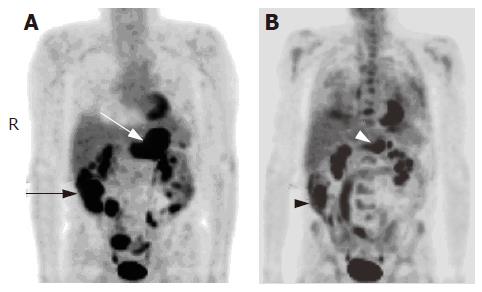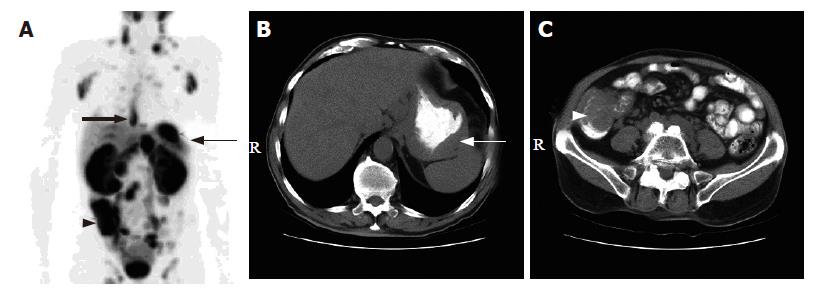Copyright
©2005 Baishideng Publishing Group Inc.
World J Gastroenterol. Dec 14, 2005; 11(46): 7284-7289
Published online Dec 14, 2005. doi: 10.3748/wjg.v11.i46.7284
Published online Dec 14, 2005. doi: 10.3748/wjg.v11.i46.7284
Figure 1 A 61-year-old woman with large cell lymphoma.
A: Pre-treatment 18F-FDG PET scan revealed multifocal hypermetabolic activity involving the neck, chest, and abdomen (arrow). The highest SUVmax was 20.3 in the left upper abdominal area, corresponding to a positive result of a gastric biopsy; B: Follow-up 18F-FDG PET scan 5 mo later showed no evidence of residual FDG disease.
Figure 2 A 68-year-old man with large cell lymphoma.
A: Base line 18F-FDG PET scan showed hypermetabolic foci in the stomach (white arrow), cecum and terminal ileum (black arrow), and bowel loops (SUVmax = 12.7); B: 18F-FDG PET scan obtained after therapy showed partial metabolic response of the activity in the stomach (white arrowhead) and cecum (black arrowhead, SUVmax = 10.7).
Figure 3 An 80-year-old man with MALT-type lymphoma.
A-C: 18F-FDG PET scans in transaxial and projection images showed a focal mild hypermetabolic activity (SUVmax = 3.8) in the region of stomach (black arrow); D and E: CT scans showed a bulky mass in the wall of gastric fundus and body (white arrow).
Figure 4 A 78-year-old man with mantle cell lymphoma.
A: 18F-FDG PET scan revealed multiple hypermetabolic foci involving the lower esophagus (thick arrow), gastric fundus (thin arrow), cecum and terminal ileum (arrow head); B and C: The corresponding CT scans of the abdomen showed wall thickening at the gastric fundus (white arrow) and the cecum and terminal ileum (white arrow head)
- Citation: Phongkitkarun S, Varavithya V, Kazama T, Faria SC, Mar MV, Podoloff DA, Macapinlac HA. Lymphomatous involvement of gastrointestinal tract: Evaluation by positron emission tomography with 18F-fluorodeoxyglucose. World J Gastroenterol 2005; 11(46): 7284-7289
- URL: https://www.wjgnet.com/1007-9327/full/v11/i46/7284.htm
- DOI: https://dx.doi.org/10.3748/wjg.v11.i46.7284












